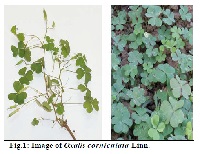The Botany, Chemistry, Pharmacological and Therapeutic Application of Oxalis Corniculata Linn– A Review
Keywords:
Oxalis corniculata, Galacto-glycerolipid, Pharmacological activities, Antioxidant, AnticancerAbstract
Oxalis corniculata Linn. is an endangered and medicinally important plant indigenous to tropical and subtropical regions of the world. Its medicinal usage is reported in Indian pharmaceutical codex, the Chinese, British and the American pharmacopoeias and in different traditional system of medicines such as Ayurveda, Unani and Siddha. The review reveals that wide ranges of phytochemical constituents have been isolated from the plant like flavanoids, tannins, phytosterols, phenol, glycoseides, fatty acids, galactoglycerolipid and volatile oil. The leaves contain flavonoids, iso vitexine and vitexine-2”- O- beta – D- glucopyrunoside. It is rich source of essential fatty acids like palmitic acid, oleic, linoleic, linolenic and stearic acids and it possesses important activities like Antioxidant, Anticancer, anthelmintic, Anti-inflammatory, Analgesic, Steroidogenic, Antimicrobial, Antiamoebic, Antifungal, Astringent, Depurative, Diuretic, Emmenagogue, Febrifuge, Cardio relaxan, stomachic and Styptic have also been reported. These repots are very encouraging and indicate that herb should be studied more expensively for its therapeutic benefits. This article briefly reviews the botany, pharmacology, biochemistry and therapeutic application of the plant. This is an attempt to compile and document information on different aspects of Oxalis corniculata and highlight the need for research and development.
References
Dubey NK, Kumar R and Tripathi P. Global
promotion of herbal medicines: India’s
apportunity. Curr Sci. 2004;37-41.
Houghton PJ. The role of plants in tradinal
medicine and current therapy. J. Altern and
Compement Med.1995;1:131-143.
Fransworth NR. Ethinopharmacology and
future drug development: the north
American experience. J. Ethinopharmacol.
;38:45-52.
Sukhder. Ethanotherapeutics and modern
drug development. The Potential
Ayurveda. Curr. Sci. 1997;73:909-928.
Tanaka JCA, Silva CCD. Antibacterial
activity of indole alkaloids from
Aspidosperma ramiflorum. Braz. J. Med.
Biol. Res. 2006;39(3):387-391.
Kirtikar and Basu. Indian Medicinal
Plants. 3rd edition, MS periodical experts,
New Delhi. 1975;1:437.
Madhava KS, Sivaji K and Tulasi RK.
Flowering plants of Chitoor district,
Andhra Pradesh, India. Student Offset
Printers, Tirupati 2008;2:54.
Mohammad IS and Mir AK. Folk use of
medicinal herbs of Margalla Hills National
Park, Islamabad. Journal of
Ethnopharmacology.2000;69:48-56.
http://www.ayurvedaconsultants.com/image
s/doctor/ayurveda/ayurvedic-herbchangeri.aspx.
http://www.indianmedicinalplants.info/Me
dicinal -Plants/Oxalis-corniculataChangeri-Indian-medicinal-plantsAyurveda.html.
The Ayurvedic Pharmacopoieia of India,
part I, (3):36-38.
Kathiriya A, Das K, Kumar EP, Mathai KB.
Evaluation of antitumor and antioxidant
activity of oxalis corniculata linn.
Against ehrlich ascites carcinoma on
mice, Iranian journal of cancer
prevention 2010;4:157-165.
Hioki M, Kaori T, Yokotani, Kunijiro Y.
Flavanoids in the leaves of Oxalis
Corniculata and sequestration of the
flavanoids in the wing scales of the pale
grass blue butterfly Pseudozizeeria maha.
Journal of plant research 2008;121:133-136.
Khare CP. Indian medicinal plants: an
illustrated dictionary. Springer Verlag Berlin
/Heidelberg. 2007;457.
Raghvendra MP, Satish S. Raveesha
KA. Phytochemical analysis and
antibacterial activity of Oxalis Corniculata,
a known medicinal plant. My Science.
;1:72-78.
Unni BG. Archana Borah. Phytochemical
and Antibacterial Study of Traditional
Medicinal Plants of North East India on
Escherichia coli. Asian J. Exp. Sci.
;23(1):103-108.
Sharangouda and Patil SB. Oxalis
corniculata (whole plant) extracts exhibit
estrogenic activities in wistar strain albino
rats. The Bioscan. 2006;1:63-67.
Manna D, Dutta PK, Achari B, Lohia AA.
Novel Galacto-Glycerolipid from Oxalis
corniculata Kills Entamoeba histolytica and
Giardia lamblia. Antimicrobial Agents and
Chemotherapy. 2010;54:4825-4832.
Mizokami H, Yoshitama K. Flavonoids in
the leaves of Oxalis corniculata and
sequestration of the flavonoids in the wing
scales of the pale grass blue butterfly,
Pseudozizeeria maha . Journal of Plant
Research. 2008;121:133-136.
Ashokk. Jain, Preeti Tiwari and Mudasir
Bashir. Nutritive Aspects of Oxalis
corniculata Linn. used by Tribals of Central
India During Scarcity of Food. Botany
Research International. 2010;3(1):35-37.
http://www.stuartxchange.org/TaingangDag
a.html.
Sumei L, Chuein L, Fengyan L, Sangwoo L,
Rong L and Yuheng. Herbs for medicinal
baths among the trasitional Yao
communities of China, Journal of
Ethnopharmacology L.2006;108:59-67.
Madhavachetty K, Sivaj JK, Rao TK.
Flowering plants of Chittoor district, Andhra
Pradesh, India. Student offset printers,
Tirupati. 2008;1:54-55.
Mohammad IS. Mir AK. Folk use of
medicinal herbs of Margalla Hills
National Park, Islamabad, Journal of
Ethnopharmacology. 2000;69:48-56.
Ameenah QF, Mala S, Joseph G and Ehian
D. Medical Ethnobotany of some weeds of
Mauritius and Rodrigues. Journal of
Ethnopharmacology. 1993;39:175-185.
Hebbar SS, Harsha VH, Shripati V, Hedge
GR. Ethnomedicine of Dharwad district in
Karnataka, India. Journal of
Ethnopharmacology.2004;94:261-266.
http://www.home-remediesguide.com/herbs/indian-sorrel.html.
Taranalli AD, Tipare SV, Kumar S. Wound
healing activity of Oxalis Corniculata whole
plant extract in rats. Indian Journal of
pharmaceutical sciences. 2004;66(4):444-
Achola KJ, Mwangi JW, Munenge RW.
Pharmacological activity of Oxalis
Corniculata. Pharmaceutical Biology.
;33:247-249.
Chitwood DJ. Phytochemical based
strategies for nematode control. Annual
Review of Phytopathology. 2002;40:221-
Silamar F, Leandro GF. Use of antagonistic
plants and natural products. In: Chen X,
Chen Y, Dickson DW. Nematology advance
and perspectives, vol 2. CAB 33.
International, UK, 2005:931-977.
Taba S, Sawada J, Moromizato Z.
Nematicidal activity of Okinawa Island
plant on the root-knot nematode
Meloidogyneincognita (Kofoid and White)
Chitwood. Plant Soil. 2008;303:207-216.
Satish S, Raghavendra MP, Raveesha KA.
Evaluation of the Antibacterial Potential of
Some Plants against Human Pathogenic
Bacteria. Advances in Biological Research.
;2(4):44-48.
Unni BG, Borah A, Wann SB, Singh HR.
Phytochemical and Antibacterial Study of
Traditional Medicinal Plants of North East
India on Escherichia coli. Asian J. Exp. Sci.
;23(1):103-108.
Satish S, Raghavendra MP, Raveesha KA.
Screening of plants for antibacterial activity
against Shigella species. International
Journal of Intergative Biology.
;9(1):16-20.
Iqbal MC, Meiyalaghan S, Wijesekara KB,
Abeyrante KP. Antifungal activity from
water extracts of some common weeds.
Pakistan Journal of Biological Science.
;4:843-845.
Verma RK, Chaurasia L, Katiyar S.
Potential antifungal plants for controlling
building fungi. Natural Product Radiance.
;7(4):374-387.
Sharangouda K, Patil SB. Antiimplantation
and abortifacient activities of Oxalis
corniculata in albino rats. Nigerian Journal
of Natural Products and Medicine.
;11:58-60.
Itani T, Fujita T, Tamaki M, Kuroyanagi M,
Fujii Y. Allelopathic activity & Oxalate
content in Oxalate-rich plants. Journal of
Weed Science and Technology.
;44:316-323.
Reddy KY, Kumar SA, Lakshmi SM,
Angothu S. Antioxidant Properties of
Methanolic Extract of Oxalis corniculata.
International Journal of Phytopharmacology.
;1:43-46.
Seraphim ER, Sinha MP. Impact of
phytoestrogens on endocrine glands of
albino rats ii. adrenal. The Bioscan.
;5(1):63–66.



